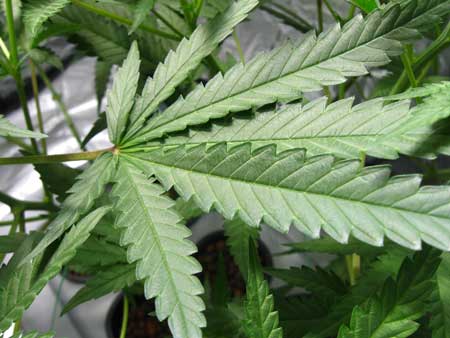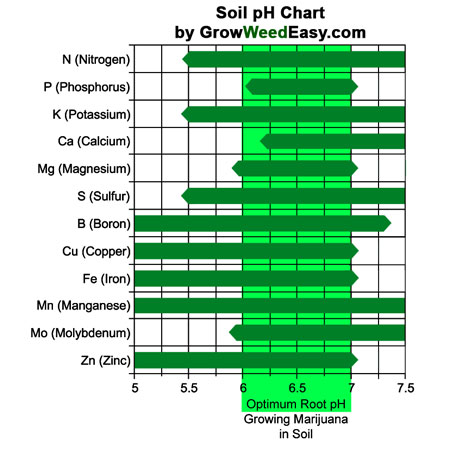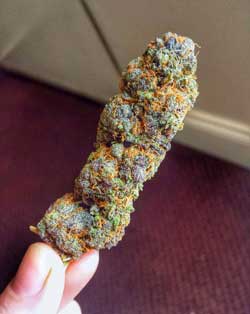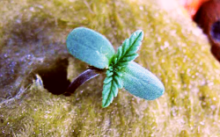Tady jsteJak Upravovat pH pro Konopí & Předejít Nedostatečnosti Živin
Jak Upravovat pH pro Konopí & Předejít Nedostatečnosti Živin
Úprava pH Zabere Méně Než 5 Minut! Přemýšlejte o tom jako o Doplňku, Který Učiní Rychlejší a Zdravější Růst Vašich Rostlin
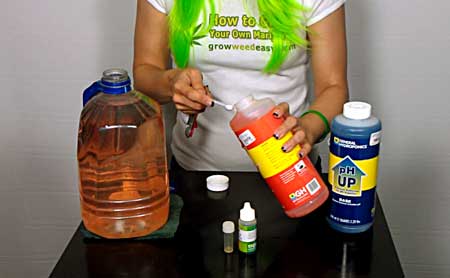
Obsah
Úvod: Jak Upravování pH Zamezuje Nedostatkům Živin?
-
pH pro Půdu (6.0 - 7.0 pH)
-
Hydro/Bezpůdní/Kokos pH Rozpis (5.5 - 6.5 pH)
Jak Otestovat a Upravit pH - Instrukce Krok-za-Krokem & Video
Shodnocení: 8 Věcí na Které Musíte Pamatovat Ohledně pH
od Nebula Haze
Úvod: Jak pH Zamezuje Nedostatečnosti Živin U Konopí?
PH je měřítko toho, jak “kyselé” nebo “zásadité” něco je, na stupnici 1-14. PH "7" je považováno za neutrální/přirozené, například čistá voda má pH okolo 7. Měřítko pH má co dočinění s vodíkem ve vzorku.
Okay, tak proč je pH důležité pro pěstitele konopí?
Konopí má přirozeně raději trošku kyselejší prostředí ve svých kořenech. Půde s lehce kyselým pH je to co způsobuje dobrý růst konopí ve volné přírodě. Správné pH v kořenech pomůhá rostlině mít dobrý přístup k živinám, které potřebuje. Pokud je pH v kořenech příliš vysoké nebo příliš nízké, rostlina pak nemůže správně vstřebat živiny a budete mít rostlinu konopí s živinovými nedostatky!
Dávání Pozor na pH Vám Zajistí Zdravé Listy Konopí!
Někteří pěstitelé mají to štěstí, že se nemusí zabývat pH. Možná měli jen správnou půdu a to jim stačilo při zalévání správnou vodou pro vytvoření perfektního prostředí pH pro kořeny. Pokud vaše rostlina roste perfektně, bez známek nedostatků, pak úprava pH není ničím s čím si musíte lámat hlavu.
Naneštěstí, mnoho pěstitelů nemá takové štěstí a jejich sestavení přirozeně má pH, které je příliš vysoké nebo příliš nízké pro optimální růst jejich konopí. Źatímco existují způsoby jak se přenést přes testování pH během pěstování konopí, téměř všichni pěstitelé konopí udělají lépe když budou brát pH na zřetel.
Úpravou pH...
-
rostliny budou mnohem méně pravděpodobněji trpět jakýmikoliv problémy s listynebo živinovými nedostatky
-
bez živinových problémů, rostliny konopí mohou růst rychleji a tvořit větší výnosy
-
občasně jsou pěstitelé varováni na určitá rizika předtím než se z nich stanou problémy, například pokud zjistíte, že pH je příliš vysoké nebo příliš nízké, můžete to napravit předtím než vaše listy začnou trpět nedostatky
Základní věc na kterou pamatovat je, že správné pH při kořenovém systému pomáhá rostlině abosrbovat živiny. Proč tomu tak je?
Živiny na sebe berou různé podoby (z chemického hlediska) v závislosti na okolní hladině pH. Některé formy jsou jednodušší absorbovat než jiné. Když je pH přiliš vysoké nebo příliš nízké, rostlina může vykazovat známky nedostatku živin i když živiny budou fyzicky v dosahu kořenů.
Při úpravě pH pomáháte rostlinám mít přístup ke všem živinám po celou dobu. Zatímco pH je důležité při veškerém pěstování, je nejvíce důležité pro pěstitelo pouřívající živiny. Způsob jakým jsou tekutá hnojiva formulovaná, jsou vysoce dostupné kořenům, ale jen ve správném rozsahu pH.
Co Je Správné pH?
-
Půda - 6.0-7.0 pH
-
Hydro/Bezpůdní/Kokos - 5.5-6.5 pH
Výsledkem příliš vysokého nebo příliš nízkého mohou být známky nedostatku živin u rostliny, i když jsou živiny přímo v pěstební médiu.
Jakmile dostanete testování pH do ruky, bude to jen okamžik který vám zabere pár vteřin. A až budete napojeni, nebudete muset ani měřit pH tak často, protože už budete vědět co očekávat.
Jaké Je Nejlepší pH pro Pěstování Konopí?
Následující obrázek vám ukáže jak jednoduché je pro rostlinu vstřebat/využít každou živinu při rozličné úrovni pH. To vám může dát něco na co se zaměřit když si povšimnete specifického nedostatku živin.
V přírodě konopí upřednostňuje kyselejší půdu. Pro půdu je optimální pH pro konopí v rozsahu mezi 6.0 - 7.0, když po nejvíce času bude mezi 6.2 - 6.9. Je dobrý nápad nechat pH pokrývat určitý rozsah namísto toho abyste měli vždy naprosto stejnou úroveň.
Podívejte se, které živiny jsou nejlépe vstřebávány při určitých úrovních pH
V půdním prostředí, kde se nepoužívá tekutých hnojiv, není pH až tak důležité. Když užívate tekutá hnojiva/živiny v půdě, budete muset téměř vždy upravovat pH, abyste zamezili problémům a zajistili co nejvyšší výnos.
Hydroponie, Bezpůdní nebi Kokosnbsp;~ 5.5 - 6.5 pH
Pro hydroponní pěstební sestavy (stejně jako bezpůdní pěstební média jako kokos) je optimální úroveň pH pro oblast kořenů ezi 5.5 a 6.5. To je o něco kyselejší než optimální úroveň pH pro půdu.
Je dobré nechat pH pokrýt určitý rozsah namísto poměřování vždy na stejné úrovně pH.
Podívejte se, které živiny jsou nejlépe vstřebány/využity při konkrétní úrovni pH
V hydroponii je nejdůležitější nechat pH hýbat v určitých rozsazích, (střídat občasně úrovně), jak můžete vidět výše, některé živiny mohou být využity jen při vyšších nebo nižších úrovních pH.
V hydroponickém sestavení budete téměř vždy používat tekutá nebo prášková hnojiva, tak si zachraňte spoustu trable sledováním a úpravou na správné pH jak bude potřeba! pH se Přirozeně časem mění, a potřebujete jej upravit jen když bude mimo rozsah 5.5-6.5.
Co ohledně bezpůdních pěstebních médií jako je kokos?
Většina bezpůdních pěstebních médií je kompletně inertních, což znamená že nemají v sobě žádné živiny pro rostlinu. Namísto fungují více jako podpůrný systém pro vaše kořeny když dodáte všechny živiny skrze vodu. Pokud rostlina dostává všechny živiny ve vodě, může to být považováno za "hydroponické" pěstební médium.
Ovšem, některá bezpůdní pěstební média s mnoha organickými látkami mohou vyžadovat o něco vyšší pH aby vzkvétaly. Například, pokud jste přidali ve větším množství žížalí čaj (tekuté žížalí hnojivo vznikající při kompostování), můžete potřebovat mířit na pH v úrovni mezi půdou a hydroponií, protože jste přidal více "půdní" komponent.
Nepotřebujete Být Přesní - Nechte pH houpat Nahoru & Dolů
Věc na kterou se vyplatí pamatovat je, že nemusíte být naprosto přesní. Jediná věc, které se potřebujete vyhnout je přespříliš vysoké nebo nízké pH v zóně kořenů vaší rostliny.
Dokud se budete držet v mezích doporučovaných úrovní, zamezíte tak většině problémů s živinami zp§dobených příliš-vysokým nebo příliš-nízkým pH.
Proč je dobrý nápad nechat pH pokrývat určitý rozsah namísto vždy upravovat na naprosto stejnou úroveň pH? Některé živiny jsou lépe vstřebány při o něco vyšších pH, zatímco jiné jsou lépe vstřebatelné při nižším pH. Nesnažit se být příliš puntičkářský také zachrání spoustu frustrace.
Pokud kořeny vašeho konopí zaznamenávají špatné pH, je doporučené zasáhnout ihned když to zaznamenáte a nečekat na případné problémy na listech. Může být svádějící ignorovat problém s pH, ale často dosáhnete lepších výsledků když zasáhnete předtím než rostlina začne vykazovat problém. Jak již bylo řečeno, pokud je vaše rostlina zelená, živá a zdravá, občas platí staré přísloví, "pokud to není rozbité, neopravuj to."
Tipy
-
Buďte důslední v tom, že pH zůstává ve správném rozsahu
-
Nepotřebujete být přesní, jen mějte oko na pozoru a reagujte dříve než se pH příliš vychýlí vysoko nebo nízko
-
Přidejte nejprve všechny vaše živiny do vody předtím než budete upravovat na kontrétní pH. Vaše živiny ovlivní pH vaší vody, takže je důležité mít je v ní předtím než budete dělat jakékoliv úpravy.
Jak Otestovat a Upravovat pH pro Konopí
Vybavení: Co Přesně Potřebuji pro Testování & Upravování pH?
‣ PH Tester
-
Digitální pH Pero/Tužka nebo
-
pH Meřicí Kit s kapkami nebo papírky
Toto jsou dvě nejčastější metody pro měření pH vody při pěstování konopí. Zjistěte více o výhodách a nevýhodách mezi Digitálním pH Perem nebo pH Meřícím Kitu.
‣ Úprava pH
-
Lahev s "PH Up" - Nahoru, a lahev s "PH Down" - Dolů
Lahvičky PH Up & PH Down vám poskytují jednu z nejlepších cest jak upravovat pH v půdě nebo hydroponii. Každá se dodává v lahvi, která vám dovolí jednoduše změřit to, kolik máte přidat do vody. General Hydroponics vytvářejí nejběžnější verzi těcdhto produktů, ale existují i jiné značky jako Mad Farmer, kteří mají pdoobné produkty, které jsou podobně dobré.
Existují i další metody úpravy pH, ale používání pH Up a pH Down je nejlepší metodou, kterou jsem vyzkoušela - Vím, že tyto produkty fungují skvěle pro pěstování konopí a udržují pH více stabilně než přírodní alternativy jako ocet nebo jedlá soda.
‣ Voda
-
Pro mnoho pěstitelů funguje voda z kohoutku dostatečně pro pěstování konopí. Potřebujete speciální vodu?
-
Používám kanystr, který byl původně vyroben pro pití vody na míchání živin, ale spousta jiných nádob bude fungovat samozřejmě stejně. Nejdůležitěji, vyhněte se používání čemukolv rozbitnému, především sklu (které může poničit vaše vybavení nebo se rozbít).
‣ Živiny (Pokud Používáte Živiny)
-
Zjistěte více o živinách pro konopí - potřebujete je pro vaše sestavení?
Jak Upravovat pH u Rostlin Konopí
-
Přidejte vaše Živiny nebo Doplňky do vaší Vody - vždy udělejte ze začátku, protože živiny mohou změnit pH vody
-
Jemně Protřepte nebo Vodu Promíchejte
-
Otestujte pH - to uděláte pH Tužkou, kapkami, nebo pH lakmusovými papírky. Co funguje nejlépe?
-
Upravte pH tím, že přidáte "PH Up" nebo "PH Down" roztok. Vaším cílem je mít vodu ve správném rozsahu pH pro vaše pěstební médium. Pokud je vaše pH příliš nízké, pak potřebujete přidat "PH Up," a pokud je vaše pH příliš vysoké, pak potřebujete přidat "PH Down" abyste měli správné pH.
-
Znovu Otestujte, abyste se ujistili, že je pH ve správném rozsahu.
-
Zalejte rostliny s pH upraveným živným roztokem nebo přidejte vodu do hydroponického zásobníku
-
Zkontrolujte - Půdní nebo bezpůdní pěstitelé, kteří ručně zalévají své rostliny by měly zkontrolovat pH jejich odtíkající vody aby se ujistili, že je ve správném rozmezí - zkuste otestovat tu vodu, která odtíká jako první. Hydroponičtí pěstitelé mohou zkontrolovat pH jejich vody tím, že otestují malý odebraný vzorek z jejich vodního zásobníku/rezervoáru o pár minut později. Jak upravím špatné pH?
To je ono!
Kolik pH plus nebo pH minus mám přidat?
The amount of pH Up or Down you add will vary a lot depending on your water. If you're using very soft water than you will need just a tiny amount of fluid to adjust the water's pH since there's not much "stuff" in the water to buffer the pH. However, if you're using hard water than you'll need to add more.
-
You'll have to add just a little bit at a time and keep testing until you get an idea of exactly how much you'll need. After 1-2 times this step will only take seconds!
-
To give you an idea, we have pretty hard water that starts out around pH 8. We need to add about 2-1/4 tsp to 5 gallons of water to get the pH down to the 5.5-6.5 range.
-
According to General Hydroponics, on average you'll use 1-2ml/gallon, or 1-2 tsp per 5 gallons.
It can be helpful to make a note of the total amount of pH up/down added. The total amount of used pH up/down will be about the same each time. Remember that number and write it down! It will make pH'ing easier in the future! The amount will change a little depending on which nutrients
Watch our video above to see Nebula give a demonstration!
Unfortunately there’s no exact formula to adjusting pH, because factors such as the source of water, growing medium, nutrients, drainage and growing setup all have an effect on pH.
You will need to use trial and error to figure out what amount of pH Up or Down works for you in your setup with your nutrients.
If you’re new to adjusting pH, start small with pH Up and Down, and only work your way up to bigger amounts after you’ve gained some experience. Most growers will be able to figure out their personal measurements within 1-2 waterings.
The very first time you pH your water, it will take a little trial and error to figure out how much PH Up or PH Down to add to get to the right number, since everyone's water is a little different. The general idea is to start with a little bit, maybe a few drops, then retest and add more if needed. Continue this until you get the water in the proper range. PH Down is much stronger than PH Up, so be extra careful with PH Down! After the first time, it will be much easier to measure out how much you need.
Tips for Cannabis Nutrient & pH Management:
-
Don’t Go Overboard: With liquid nutrients, it’s usually better to give too little than too much. You can always add more, but it’s harder to take nutrients back. A good rule of thumb is to start out at half the recommended dose, and only raise nutrient levels if the plant needs it.
-
Never Mix Nutrients or Supplements Directly With Each other: Always add nutrients directly to your water. It’s bad to mix nutrients together. They can react with each other in a way that can make nutrients less available to your plants. Most nutrient bottles or pH adjusters will come with a clear warning that says the same thing. Always add any additives directly to the water - your plants will thank you for it.
-
Tap Water Can Be Easier to pH Than RO or Highly Filtered Water: Tap water or mineral water has an extra buffer of extra minerals and other “stuff” in the water. This helps prevent the pH from swinging up too high or too low quickly and can make pHing easier. RO water has very little buffer (it’s basically pure water) and tends to swing up and down in pH easily with just a little pH Up or Down. Do you need special water or is your tap water good enough?
-
Shaking Water Changes the pH: When checking and adjusting pH, some growers like to shake their water container to make sure everything is evenly mixed. This works well, and roots love the extra dissolved oxygen, but it’s important to understand that after shaking the nutrient water for a long time, the additional dissolved oxygen will raise the pH of the water. Don’t worry about this - don’t retest then readjust the pH. If you’re going to hand-water to your plant, you want to make sure you go by the pH of the water before it was shaken up. In hydro, the water is going to be oxygenated anyway, so shaking it before testing is ok. If water is allowed to sit for a while, it’s normal for the pH to change a bit. When it comes to mixing, make sure you mix water gently so nutrients and pH Up or Down are evenly distributed, but avoid vigorous shaking until after you’ve already adjusted the pH.
-
pH Drift is Normal. Try to keep pH in the suggested range and you’ll be fine, even if it's on the higher or lower end of the scale.
Summary of Steps
-
Adjust pH - Instructions
1.) First get a ballpark figure of the current root pH
Soil or Soilless Mediums
-
Next time you water the growing medium, test the pH of the water going in
-
Test the pH of the water that runs out of the bottom (runoff water)
If the pH of the runoff is in the right
range, even if it's not the same as the pH you put in, you're
good. If the pH of the runoff water coming out is too high or
too low for your range, you know that you'll need to correct the
pH.
Hydroponics
-
Test the pH of the reservoir by taking a small sample of water and use it to test the pH.
If the pH is outside the 5.5-6.5 pH range, you know you'll need to correct the pH.
2.) If pH at Root Zone is Off, Adjust the pH
Let's break down exactly what you need to do!
Hydroponics (roots
in water)
Tips For hand-watered plants... (soil or soilless)
Think about the pH of the water that you watered your plants with. You made sure it was in the right range. So if the pH that comes out the bottom is outside the range, that means you need to either raise or lower the pH to get it back where it should be.
Flushing - pH problems are sometimes caused by over-fertilizing (the plant was given too many nutrients or supplements, which builds up salts in the growing medium). If you believe this is the case, flush the growing medium to remove salt buildup. This should only be done when the regular method isn't working for you, and/or you have no other choice. Flushing means giving your plants 1-3 times the volume of its container with plain, pHed water. The flush leaches out extra nutrients and salts. After the flush, water plants with a light nutrient solution. It’s normal for plants to droop when they’ve been flushed (showing signs of being overwatered), but the drooping will go away as soon as the medium begins to dry out. After the top inch of growing medium has dried out, water the plant as normal and test the runoff water to see if the pH has corrected itself.
Water going in should be 6-7 pH
If runoff pH is...
- 6-7 pH - in the right range, no changes needed.
- Less than 6 - provide next watering at pH 7
- More than 7 - provide next watering at pH 6
Continue this formula with each watering.
Water going in should be 5.5-6.5 pH
If runoff pH is...
- 5.5-6.5 pH - in the right range, no changes needed.
- Less than 5.5 - provide next watering at pH 6.5
- More than 6.5 - provide next watering at pH 5.5
Continue this formula with each watering.
Maintaining pH is especially important in hydroponics. Luckily it's really straightforward since you only have to worry about the water in your reservoir. However, if the pH is off in between reservoir changes, you can make adjustments.
-
If pH is too high, add a tiny amount of "PH Down" solution to your reservoir (a little bit goes a long way with PH Down). Return to reservoir and check pH again in a few minutes.
-
If pH is too low, add a small amount of "PH Up" solution to your reservoir. Return to reservoir and check pH again in a few minutes.
Tips for Hydroponics Growers
- The pH of the water tends to go up when the water is oxygenated (for example by adding bubbles or shaking water) - this is normal.
- The pH also changes as plants use up nutrients in the water
- It's a good idea to completely change your reservoir at least once every 1-2 weeks, especially in the flowering stage when plants are more picky. This constant renewal helps prevent a lot of pH problems as well as nutrient buildup in the reservoir.
- Test reservoir water regularly so you spot any pH problems before they damage your plants
3.)Keep Testing! Learn if you need any more adjustments.
If you’ve recently adjusted the pH of your growing medium or hydroponic setup, or made any other major changes, it’s important to keep testing pH regularly!
Digital PH Pen vs Drops or Strips
The most common way to test for the pH of water is probably using drops or strips. These work by taking a water sample, and you compare the color produced to a chart. These give you a rough idea of the pH.
Digital pH pens look a bit like a thermometer. Basically you dip the end into your water and a digital readout on the screen will tell you the pH.
They each have their pros and cons, so it's important to figure out which one works better for you.
PH Strips or Drops
Pros
-
Easy
-
Cheap
-
Quick
Cons
-
Not as exact as a PH Pen
-
Some people don't like using a color chart (learn some tricks)
-
It can be hard to read the color in different colored lighting
-
Harder to use if you have dark nutrients that stain your water
Digital PH Pen
Pros
-
Get an exact reading of the pH on a digital screen
-
Very quick - just dip the pen into the water for a few seconds and the pH will show up on the screen
Cons
-
Can be easy to break
-
Needs to be stored properly
-
Needs to be calibrated
-
Requires purchase of 4 separate fluids; gets pricey quickly
This type of pH Test Kit works by using drops or strips that turn a color to reveal the pH of your water, using a color chart. Basically you take a small sample of water in an included test tube, add a few drops of the pH solution or dip the strip, and then match the resulting color to figure out the pH.
Many pH Control Kits come with pH Up & pH Down included. Even though they're often sold by "General Hydroponics," these kits work great for soil in addition to hydroponic applications.
Directions
Find the pH - watch the video
-
Take small water sample in included test tube
-
Add a few drops of pH fluid (or dip strip)
-
Match the color to find the pH (compare to chart)
Adjust the pH:
-
Add a small amount of PH Up to bring it up
-
Add a small amount of PH Down to bring it down
-
Re-test
How Do Digital pH Testers Work For Growing Cannabis?
Digital pH Pens offer a precise way to measure the pH of your water. No need to squint at a color chart with a pH Pen, you simply look at the number printed out on your screen
 Hanna Instruments HI 99104 pH Tester -
this one doesn't get rave reviews, but it's been reliable and
accurate for me for years and many grows.
Hanna Instruments HI 99104 pH Tester -
this one doesn't get rave reviews, but it's been reliable and
accurate for me for years and many grows.
About the HI99104 pH Tester Model:
-
You'll need a coin the calibrate this tester
-
You'll need to get calibration solution (like every pH tester)
-
Follow the directions, including use and storage - it's pretty straightforward
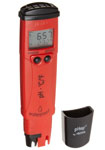
Hanna Instruments HI 98128 pH Tester - this high-end tester has all the bells and whistles you could possibly want from a digital pH Tester, but may be overkill for new growers.
About the HI98128 pH Tester Model:
-
You'll need to get calibration solution (like every pH tester)
-
Follow the directions, including use and storage - it's pretty straightforward
All testers come with step-by-step directions that tell you exactly what you need to do to get a quick, easy and accurate reading every time! In order to make sure your pH pen stays accurate, you need to get a few extra bottles.
-
 Calibration fluid - You
get a "4.01" & "7.0" bottle together as a kit, and you
need both of them to be able to calibrate your pH pen
Calibration fluid - You
get a "4.01" & "7.0" bottle together as a kit, and you
need both of them to be able to calibrate your pH pen -
Storage Solution - Not 100% necessary, but it extends the life of the pen
-
Cleaning Solution - Not 100% necessary, but it extends the life of the pen
If you don't get all these extra items, you won't be able to take the best care of your digital pH tester and it won't give you accurate pH readings and they won't last nearly as long.
All testers come with step-by-step directions that tell you exactly what you need to do to make sure you pH tester is accurate for years to come!
Don't get a "TDS" or "PPM" meter by accident! It's different from a pH pen!
There are many other digital pH testers besides the ones listed above, and many of them will work great. Just be sure you don't actually buy a "TDS" or "PPM" meter by accident, which is different and does not actually test pH. If you want a TDS meter, that's great, but many growers accidentally buy one and don't realize what it's actually for. Learn more about TDS & PPM.
What to Do After You Test the pH
After using your pH pen, you use a bottle of PH Down & PH Down to adjust the pH to where it should be, if needed.
How to Adjust the pH
-
Add a small amount of PH Up to bring it up
-
Add a small amount of PH Down to bring it down
-
Re-test
Common pH Problems & Questions
Common pH Problems
Common Questions About pH
I'm using pH drops and I can't tell which color it's turning.
Try addition more drops of indicator fluid, as well as using fewer drops. When there's not enough, or two much of the indicator fluid in your vial, it makes it really hard to tell what color the water is turning.
Take a look at the pH pen itself. Is the electrode broken? It looks like a glass bulb on the end of the pen.
Next, was it stored properly? What that means is, was it stored with storage fluid in the cap. If it was stored dry, it can break the pen even if everything looks okay.
Ok, you're pretty sure the pen itself is okay, so the next question is whether it's been calibrated properly. Have you recently calibrated it with the 4.0 and 7.0 calibration fluid? An uncalibrated pH pen can give you a wildly inaccurate readings.
Lastly, is the battery ok? These batteries last a really long time but it's still something to check.
My pH keeps changing when I'm testing
Something to keep in mind is shaking your water actually temporarily raises the pH. So if you keep shaking the water and testing again, you're going to notice that the pH reading is different.
If you're using pH fluid or strips, make sure you're following the directions closely. Adding too much or too little fluid will make it impossible to track the pH.
If you're using a pH pen, make sure pH tester is working by testing it on 4.0 and 7.0 calibration fluid.
My runoff pH is too high/low, what do I do?
If the pH is really far off, or if plant is suffering from toxicity or severe nutrient burn, it may be a good idea to flush the growing medium first. What that means is that you give the plant enough water to get lots of runoff. This helps "flush" out any extra nutrients or salt buildup in the soil. Only flush if you absolutely need to, though! Flushing can temporarily slow down the growth of your plant, so it should only be used in an emergency.
If the runoff is only off by a little bit, you can correct the pH by changing the amount of pH Down or pH Up you provide the plant when watering.
Here's the full instructions with step-by-step help on how to fix an incorrect pH.
Everything is fine, should I worry about pH?
PH is certainly something to be aware of in order to prevent the plant from showing nutrient deficiencies, but honestly "if it ain't broke don't fix it!" If your plant is growing fast and all the leaves look green and healthy, there's really no reason to change anything. That being said, if you start noticing nutrient deficiencies in your leaves, the very first thing to check is the root pH.
Do I pH the water before or after adding nutrients?
Add nutrients first, then pH the water.
You should test the pH after you add nutrients to the water (if adding nutrients). The nutrients will often change the pH of the water, and you’re concerned with making sure the pH of the water is right, as experienced by the roots.
If not using any nutrients for this feeding, simply adjust the pH of the plain water.
How Easy is it to Use Liquid Nutrients and Maintain pH?
Liquid nutrients for plants are simple to use (usually consisting of 1-3 bottles for all stages of life) and don’t take up much space. These nutrient systems can be used to provide exactly the right nutrients for your cannabis plant at each stage of life.
Learn about nutrients & get customized nutrient schedules for growing cannabis
Many growers use liquid nutrients made for soil to supplement their soil grow. There are also nutrients which are made to be used in hydroponic setups to provide all the nutrients the plant needs throughout its life, even without soil.
Whether made for soil or hydroponics, all liquid nutrients are used in a similar way.
The Hydroponics vs Soil debate continues to rage on, but no matter what your choice, the nutrients available today have exactly what’s needed by a cannabis plant to thrive at all stages of life, coasting perfectly to harvest time.
For soil growers, being aware of pH is important, especially those using liquid nutrients. For soilless and hydroponic growers, liquid nutrients and pH management are required tools that give growers a greater ability to affect plant growth - for better or worse.
Note: Some soil growers will add a handful of dolomite lime as they're mixing their soil. Dolomite lime can help buffer pH and keep it from getting too low, while also adding a source of calcium and magnesium. But lime should be added before you start your grow so it has enough time to break down, so this method is not recommended unless you're mixing up your own soil. Learn how to mix up your own soil for growing cannabis.
No way, maintaining pH for your cannabis grow can be easy and intuitive!
Learn all about how to check and adjust your pH for cannabis
Measuring and adjusting the pH is as simple a process as mixing up the nutrients themselves. The pHing process can take less than a minute, and the results you’ll get in better growth and bigger colas are worth the few minutes it takes to pH.
Basically you take a small sample of your water and test to find out the pH.
You can use a pH Control kit or a digital pH tester. The pH control kit has you add a few drops of a special solution to your small water sample and match the resulting color to find the pH. A digital pH tester can be stuck directly in the water to get the pH printed on a small screen, but requires regular calibration and proper storage with storage solution to stay accurate.
Whether you’re using a pH control kit or a digital tester, basically you use your water sample to learn the pH. You have “pH Up” or “pH Down” solution to adjust if it's too high or too low.
How to bring pH up or down outdoors
Great for outdoors, these options for adjusting pH are not recommended for indoor growers unless you know what you’re doing :)
Note: There are other methods of natural pH management besides the ones that follow, but these are the ones we know will definitely work. They are intended for growers who are growing on larger patches of land and need to change the pH of a lot of soil.
Bring Up pH
Lime is one of the most proven ways to bring up the pH of soil outdoors.
-
Use agricultural or garden lime in soil to bring up pH (the smaller the particles of lime, the sooner they will become available). This type of lime (agricultural or garden lime) adds pleny of Calcium, too, but not a lot of Magnesium.
-
Dolomite lime will add plenty of Magnesium in addition to Calcium. Many cannabis growers like to add handful of dolomite to their soil when mixing it up to buffer the pH and provide a steady source of calcium and magnesium.
Mix lime thoroughly with the soil, and keep it relatively moist to “activate” the lime. The finer the limestone source, the quicker it will be absorbed - powdered lime works much more quickly than larger sources of lime, which take time to break down.
Liming to bring up pH and enrich with Calcium/Magnesium should be used at the beginning of the grow before plants are placed in the soil. Cannabis likes slightly acidic soil, so it's important not to go overboard and bring the pH too high (soil for cannabis should be pH 6.0-7.0, so pH 7.0 and above is too high).
Don't use lime unless you follow the directions closely, you don't want to cause a bigger problem than the one you're trying to fix.
Adding lime in the middle of a grow can cause or mask a bigger problem with the nutrients and salt buildups in the soil. You’ll get the best results if you add the lime to moist soil 2-3 months before growing, so the lime has time to break down in the soil and adjust the soil pH.
However, some cannabis growers do add lime to their flowering cannabis plants grown in soil to help buffer the pH and keep the pH from dropping. When adding lime in the middle of a grow (after you've established that there's too-low ph in the soil) do not add more than 1 teaspoon (5 ml) per gallon of soil.
Bring Down pH
There are a few common way to bring down the pH of soil:
-
Aluminum sulfate - works more quickly
-
Elemental sulfur - tends to take longer
Alkaline soil needs to have the pH lowered to grow cannabis. Cannabis needs a soil pH of 6.0-7.0, and alkaline soil has a pH above 7.
Just like lime, using aluminum sulfate or elemental sulfur to bring down pH can be tough to get just right. Don't use lime unless you follow the directions closely, you don't want to cause a bigger problem than the one you're trying to fix.
While aluminum sulfate is effective at lowering the pH in a relatively short amount of time, elemental sulfur should only be used at the beginning of the grow. You’ll get the best results if you add the elemental sulfur to moist soil 2-3 months before growing, so the sulfur has time to break down in the soil and adjust the pH. Depending on where you live, Sulfur (or “Sulphur”) is also known as "soil sulfur," "powdered sulfur" or "flowers of sulfur."
How Do I Learn More About My Local Water?
Check with your water company to learn more about your tap water. They will be able to provide you with lots of important info.
You can also do some testing on your own such as...
-
pH (discussed in this article)
Special Water Won’t Help Your Grow Unless You Need It!
Many growers don’t need special water. Some growers think that special water will somehow give them better results when it comes to cannabis growth and harvest. The truth is, special water is not going to help your grow unless you actually need it.
What options do you have if your water is not good for growing cannabis?
-
RO (Reverse Osmosis Water) - RO gives you nearly pure H2O. Everything has been taken out of the water, including minerals. With RO, you have a blank slate to start with, so you have 100% control over the water in your grow. However, with RO water, there’s less buffer to help prevent pH fluctuations. PH tends to swing up and down more easily in RO water. RO also tends to be associated with calcium and magnesium deficiencies (since these minerals are normally found in water), so adding a Cal-Mag supplement is usually beneficial for RO growers.
-
Filtered or Store-bought drinking water (treat similarly to tap water)
-
Rain water (treat similarly to tap water - some rain water isn't good)
How Can I Get Out of Managing pH?
Growers who rely on using properly amended and/or composted soil are the least likely to be hit by nutrient deficiencies caused by pH problems. The more organic matter in the soil, generally the less the soil pH matters as far as nutrient absorption. The natural process of soil breaking down helps make nutrients more available to the roots. But cannabis needs very specific nutrient requirements to get the best results.
Growing in Soil? You may not need to worry about pH
If you want to grow cannabis without worrying about pH, you’ll likely want to grow using amended, composted soil. Read about composting your own soil for growing cannabis. However when it comes to composting soil, it generally takes a bit of time, space and mixing before your soil is ready to use.
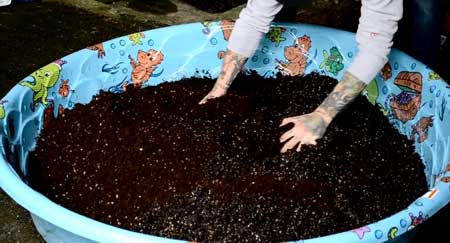
No Time to Compost Your Own Soil? Liquid Nutrients are Easy, Cheap & Effective
A lot of growers don’t have the time or space to mix up their own soil, which may involve amending, understanding how micro-organisms in the soil affect nutrient absorption, maintaining a compost pile, etc. Because growing in soil can involve a lot of prep work (or for those who live in a city where there’s not enough room for an organic, composted soil grow), there are hundreds of liquid nutrients which can be much more convenient for cannabis gardeners.
Liquid nutrients provide plants with everything they need at all stages of life. By following a simple nutrient schedule, growers are able to use the perfect amount of nutrients at the right time to power the growth of the plant, leaves and buds.
Whether you’re growing in soil or hydroponics, you can use cannabis nutrients to make sure your plants have all nutrients needed, without having to mix up any soil yourself. Just follow the basic instructions for the nutrients, and your cannabis will thrive.
For many growers, liquid nutrients make growing cannabis more simple, straightforward and satisfying.
Learn
About Liquid Nutrients for Cannabis:
http://www.growweedeasy.com/cannabis-nutrients
Who Should pH? Everyone Who Uses Liquid Nutrients
Paying attention to pH is pretty much required for any cannabis growers using liquid nutrients. Even soil growers using liquid nutrients should pay attention, though soil growers tend to get more of a buffer from all the organic matter, especially those starting with great composted soil that has been made for a plant like cannabis.
Unless you're willing to learn about soil for cannabis and mix up your own soil, there's often no way you can get out of pH management - if you refuse to manage pH, your only option is to just try it your way to see what happens.
Some growers get lucky winging it, and if you’ve successfully grown a plant like tomatoes or corn, you’ll probably be able to provide for your plants using what you already know.
But if you’re just thinking about buying standard potting soil from the local garden store, or using soil you found around your house, you’re probably going to need liquid nutrients to supplement your cannabis grow for the best results and yields. Maintaining pH is one of the best tools you have to get the most from your nutrients.
Summary: What You Need to Remember About pH & Growing Cannabis
1.) Always test the pH of water you give your plants (it takes under 5 minutes).
- Testing - you can use digital pens or a pH Test Kit with drops or strips
-
Get a bottle of pH Up & pH Down - these magical bottles of fluid give you a way to adjust the pH up or down quickly and with precision
2.) If you are using nutrients and still seeing nutrient deficiencies, the first thing to do is check is the pH, since the wrong pH can prevent plants from absorbing nutrients effectively
3.) You may need to flush plants with extra water if the pH is way out of whack
4.) Add all your nutrients and supplements before testing/adjusting pH. Many nutrients/supplements can change the pH of your water. Make sure to add everything to your water before you attempt to test or adjust the pH.
5.) It's okay/good to let pH drift up & down as long as it stays in the right range - Soil pH should be between 6.0 - 7.0. Hydroponics pH should be between 5.5 - 6.5
Jump to...
7 Steps to Fix 99% of Growing Problems
Train Your Plants for Bigger Yields

